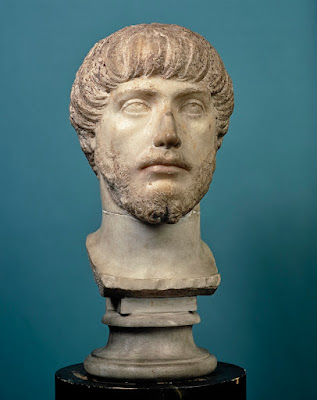 |
| Roman Republic Aes Grave with Head of Janus 225-217 BC bronze Saint Louis Art Museum |
 |
| Ancient Greek Culture in South Italy Stater of Terina Head of Nymph and Seated Nike 4th century BC silver Cleveland Museum of Art |
 |
| Roman Empire Bust of Menander 25 BC-AD 50 bronze Getty Museum, Los Angeles |
 |
| Roman Empire Bust of an Athlete 2nd century AD marble Hermitage, Saint Petersburg |
 |
| Roman Empire Bust of Germanicus (nephew and heir of Tiberius) AD 20-40 marble Getty Museum, Los Angeles |
 |
| Roman Empire Head of Augustus 1st century AD marble Detroit Institute of Arts |
 |
| Roman Empire Head of Cicero AD 100 marble (note disgraceful layers of dust on the base) Chrysler Museum of Art, Norfolk, Virginia |
 |
| Roman Empire Head of Dioskouros AD 130 marble Princeton University Art Museum |
 |
| Roman Republic Head of Gaius Cornelius Gallus (possibly) 30 BC marble (made in Egypt) Cleveland Museum of Art |
 |
| Roman Empire Head of a Man 1st century AD marble Saint Louis Art Museum |
 |
| Roman Empire Head of a Man 2nd-3rd century AD marble Detroit Institute of Arts |
 |
| Roman Empire Head of a Man 2nd century AD marble Saint Louis Art Museum |
 |
| Roman Empire Head of a Man 2nd century AD marble Scottish National Gallery, Edinburgh |
 |
| Roman Republic Head of a Woman 2nd-1st century BC marble Princeton University Art Museum |
 |
| Roman Empire Necklace with Lion-Head Closures 4th century AD gold Walters Art Museum, Baltimore |
 |
| Joseph Wilton Replica of the Head of Laocoön 1758 marble Victoria & Albert Museum, London |
"Did you know," Edward remembered saying, "that when Job was finally restored to prosperity and family abundance, one of his daughters was called Box of Eye-Paint? Can we really imagine our tormented hero enjoying his actual reward?"
"No," said Harvey. "He continued to suffer."
"Not according to the Bible."
"Still, I'm convinced he suffered on. Perhaps more."
"It seems odd, doesn't it," Edward had said, "after he sat on a dung-heap and suffered from skin-sores and put up with his friends' gloating, and lost his family and his cattle, that he should have to go on suffering."
"It became a habit," Harvey said, "for he not only argued the problem of suffering, he suffered the problem of argument. And that is incurable."
"But he wanted to argue with God."
"Yes, but God as a character comes out badly, very badly. Thunder and bluster and I'm Me, who are you? Putting on an act. Behold now Leviathan. Behold now Behemoth. Ha, ha among the trumpets. Where wast thou when I laid the foundations of the earth? And Job, insincerely and wrongly, says, "I am vile." And God says, All right, that being understood, I give you back double your goods, you can have fourteen thousand sheep and six thousand camels and a thousand yoke of oxen, and a thousand she-asses. And seven sons and three daughters. The third daughter was Keren-happuch – that was Eye-Paint."
– Muriel Spark, from The Only Problem (1984)